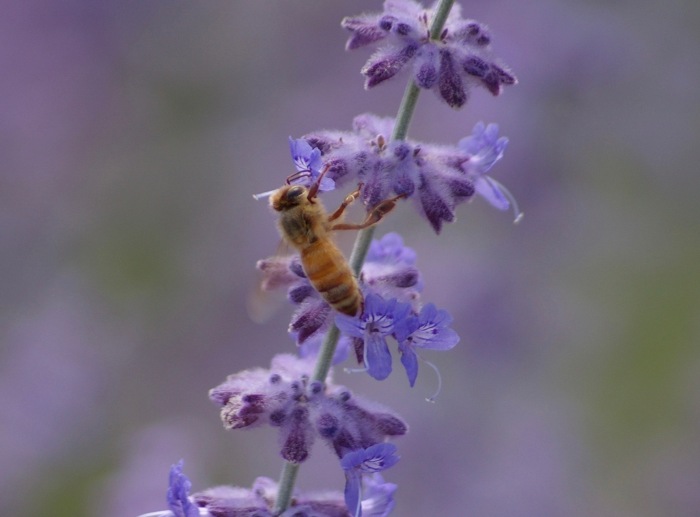
I’ve developed a routine of coming to a coffee shop in the mornings to work on writing or do some reading. This coffee shop is in a renovated late nineteenth century home and takes up almost the entire first floor.
I try to get there early, just after they open most days, and I have a regular table in the front sunroom right next to a large picture window. I’m there so often even the baristas have started referring to it as “my” table. When the sky is clear it gets sunlight in the morning as soon as the sun clears the roof of the Italian market next door. There are some shrubs along the house outside the window, so the window pane outside doesn’t get washed often.
During the last spring and summer I watched a funnel-weaver spider build a web outside in the lower corner of this window right beside my customary seat. Usually there wasn’t much of interest to see, but occasionally I got to witness a miniature natural drama play out there.
In my area—similar to many, I understand—honeybees are stressed and in decline. Though I encourage clover and other flowers on my lawn for pollinators, and I don’t use pesticides, seeing a honeybee has become sufficiently infrequent as to be a noteworthy sight. Late last summer as I entered a shop which had a flowering bush outside, I noticed what I at first thought were two honeybees. I quickly realized, however, that one of them was instead some sort of fly that mimicked the appearance of a honeybee. It hovered in a manner that honeybees don’t do and lacked the pollen sacs on its hind legs.
As I watched, the bee-mimicking fly dove at the real honeybee, striking it. The bee fell, convulsing, apparently dying as the fly hovered nearby. Horrified, I slapped at the fly, but of course there was nothing I could do for the bee.
My immediate impulse had been to protect the honeybee—who doesn’t love honey, after all?—but rationally, that predatory fly was just as much a part of nature’s web as the bee. Over the previous couple months I’d had no difficulty watching the spider outside the window by my seat at the coffee house capture flies and eat them. This, logically, was no different.
And yet it was.
I have to admit that I play favorites with nature. I love honeybees and butterflies. Parasitic wasps and carrion flies creep me out. I think a part of me could easily accept the loss of every mosquito on earth, or at least the sub-species of mosquitos that feed on mammalian blood and transmit diseases.
We need pollinators. Of course, several species of songbirds need mosquitos too, and I wouldn’t want to further stress them. As much as we’d like to, I don’t think it’s wise to pick individual winners and losers among insect species.
But yes. I love honeybees.
A few writing related news items to catch up on:
I had two poems published in “300 Days of Sun” the literary journal of the Nevada State College Humanities Department. The poems are “Super Nova” and “Gravity’s Embrace.” They’re in the lead position of the journal, pages one and two. Information about the journal is at https://300daysofsun.weebly.com/
Embark Literary Journal published the opening 4000 words of my novel, “The Great Disruption,” which I’m currently shopping around to agents. You can read the excerpt at https://embarkliteraryjournal.com/issues/issue-9-july-2019/
Here is the draft of the dust jacket blurb:
More than 99.99% of the population died in a plague. A chance viral mutation? A biological weapon? No one left alive knew for sure. But for a couple of years before the plague society was was increasingly torn apart by some mysterious pervasive illness that killed 80% of all boys before their first birthday, though girls were immune. Many suspected a rogue government actor was responsible.
Those who gathered to riot spread the plague and died. A few people hid from the rest of society and survived. Now they have to find each other and rebuild civilization.
Leaves of Ink published my poem, “It Could Have Been Beautiful.” It’s available online at http://www.leaves-of-ink.com/2019/09/it-could-have-been-beautiful.html

 There’s a place I know near Black Hand Gorge, west of Nashport, Ohio. You pull off the road and into a parking lot by a public hunting area, walk down the path into the woods, take the first fork to the left to a little woodland pond surrounded by pine, maple, and oak trees. It’s a big enough pond that it has fish, though mostly the blue-gills there are small.
There’s a place I know near Black Hand Gorge, west of Nashport, Ohio. You pull off the road and into a parking lot by a public hunting area, walk down the path into the woods, take the first fork to the left to a little woodland pond surrounded by pine, maple, and oak trees. It’s a big enough pond that it has fish, though mostly the blue-gills there are small.